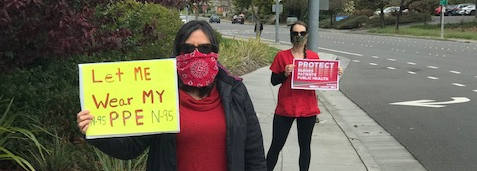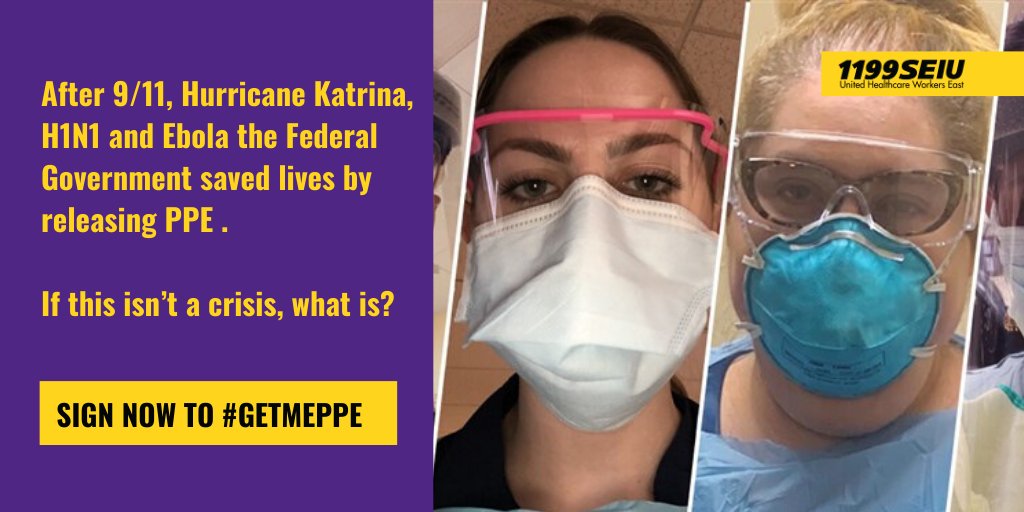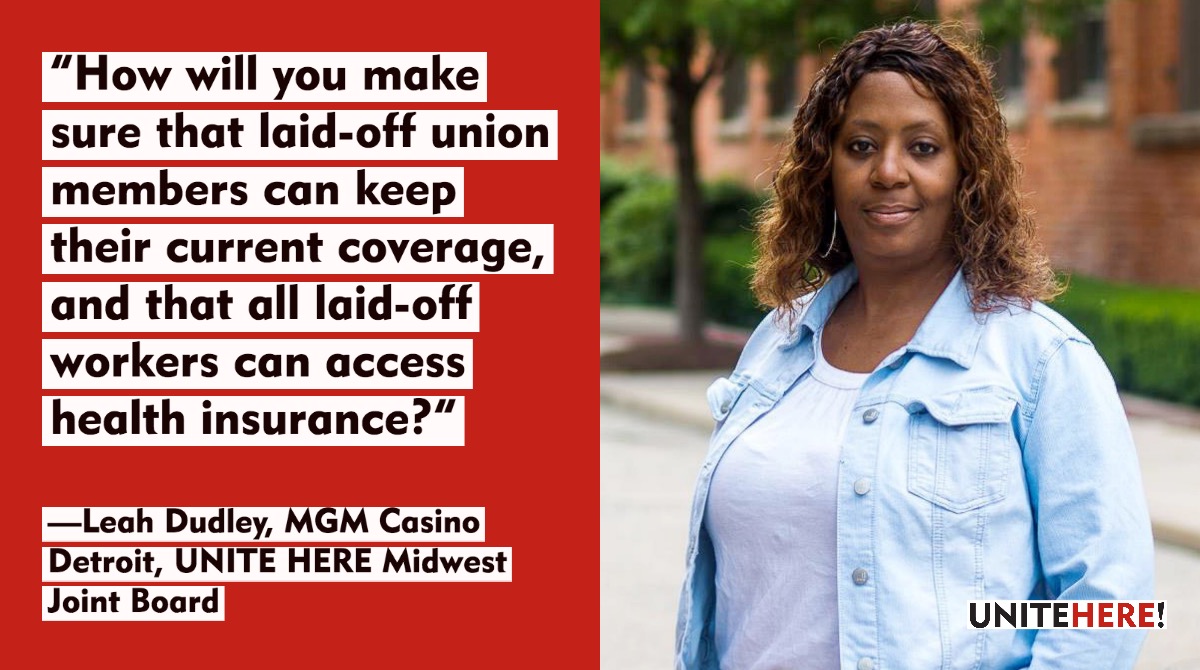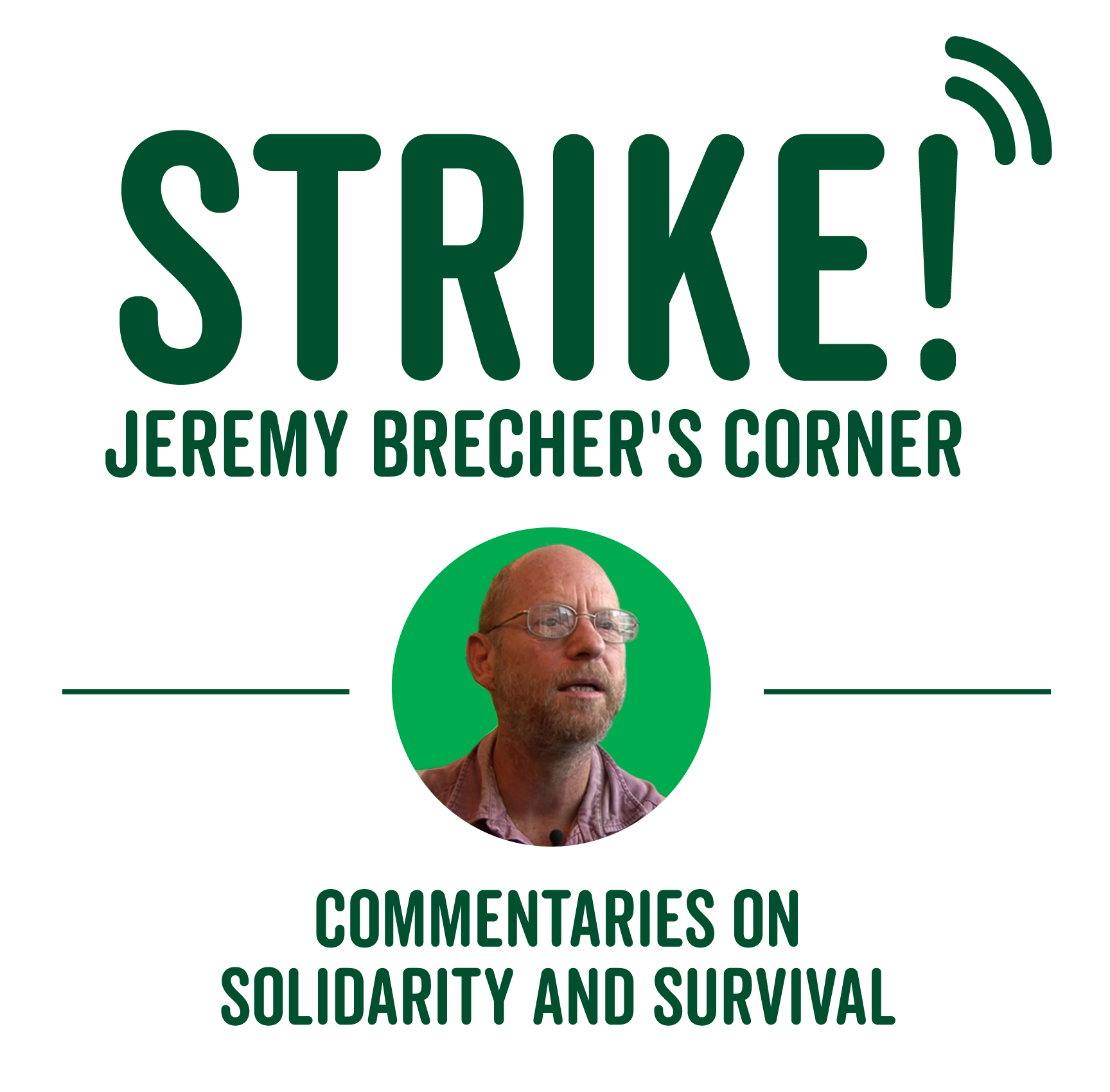This is the second in a series of commentaries on Workers vs. Coronavirus. The first, “Strike for Your Life,” describes how in recent weeks workers in diverse industries and regions have initiated more than a dozen strikes to demand better protection against COVID-19 and how such action might spread. This commentary, “I Talk to Workers Every Day – They’re Afraid They’re Going to Die,” tells how the coronavirus pandemic is affecting workers on the job based on direct reports from leaders of seven unions. Subsequent commentaries will address what unions are doing to protect workers and how environmental and other allies are supporting their efforts.

Above: National Nurses United members from Twitter @nationalnurses.
On March 26, the Labor Network for Sustainability convened a videoconference in which leaders of the environmental, climate, and climate justice movements heard directly from leaders of seven unions about the impact of the COVID-19 pandemic on their members and what they are doing about it.[1] The trade unionists included:
- Randi Weingarten, President of the American Federation of Teachers
- Sara Nelson, President of the Association of Flight Attendants-CWA
- Maria Castañeda, the Secretary-Treasurer of 1199 Service Employees International Union, United Healthcare Workers East
- Gwen Mills, Secretary-Treasurer of UNITE HERE
- Bruce Hamilton, International Vice President of the Amalgamated Transit Union
- Faye Guenther, President of the United Food and Commercial Workers Union Local 21, Washington state
- Marti Smith, Midwest Director, National Nurses United
While the industries they represent are by no means the only ones affected by the pandemic, their experiences are shared by many other workers who are also facing— and fighting—coronavirus in their workplaces.
Healthcare workers are the most obviously threatened by the pandemic. Marti Smith is the Midwest Director for National Nurses United, which is the largest union of registered nurses in the country, representing 150,000 registered nurses. She says the novel coronavirus global pandemic is “a crisis for everyone,” but it has a “particularly severe impact on registered nurses and other healthcare workers.”
I represent the nurses in the Midwest, and currently in Chicago, where we’re about a week behind New York, we have just under 200 nurses in quarantine and 11 confirmed positive COVID nurses. Now, we’re wildly under-testing. The hospitals don’t even bother to tell the nurses when they have been exposed.
Nurses have to wear masks over their faces to shield them from viral particles coming into their lungs. Now, to give you an idea, you and I will get infected because we walk through a cloud of viral particles that someone sneezed. Now imagine that you’re in the room with someone who is sneezing and coughing all day long. That’s called viral load, meaning that you’re going to get a hundred or a thousand times the amount of viruses in quarantine and 11 confirmed positive COVID nurses. Now, we’re wildly under-testing. The hospitals don’t even bother to tell the nurses when they have been exposed. virus that you or I would get because you’re in the room all day with them, right? What that means, is that in Italy, for example, 15% of the people on ventilators in Italy right now are healthcare workers.
Marti Smith says that an estimated that 40 to 70% of Americans will become infected, with possibly a million deaths. “Of course, we won’t know who that is, for the purpose of isolating the virus, because we are woefully under-testing.” That means 21 million or more people in the United States will need hospitalization, at a time when the country only has 925,000 hospital beds. This shortage extends to ventilators, negative pressure isolation rooms, and intensive care beds, critical for treating COVID-19 patients. The effect is made more severe by “years of public health cutbacks” by politicians of both major parties, and hospital employers “obsessed with just in time management practices that have stripped the healthcare safety net to the bone.”
There is a massive shortage of personal protective equipment (PPE). Smith says There are 11 million N95 respirators in the national stockpile. Most of them are expired. When you put them on over your head, the elastic pops because it’s old. “We need ventilators, but we actually need non-infected nurses to operate them. We need non-infected healthcare workers to operate them. If we are not protected, we will be infected. And then it won’t matter how many hospital beds and how many ventilators we have.”

Image: Twitter @1199SEIU.
Maria Castañeda, 1199 SEIU, represents healthcare workers, subject employees including schools and childcare, airports and traffic workers, janitors and others. She says,
I want to salute them, because they work every day despite the fear and concern that they themselves may get infected while working all day in the hospital taking care of patients, in nursing homes, and doing home care, with people in the home. They go home tired, but they cannot hug their loved ones for fear of bringing them infection. This is the day to day life of our frontline healthcare workers.
Frontlines Beyond Healthcare
The range of workers threatened by the pandemic and its side effects reaches far beyond the healthcare industries. Sara Nelson is head of the flight attendants union. She says, “The people that I represent are really struggling.”
We’ve been on the front lines of the Coronavirus for two months now. We just had a long-time union rep die. He took a COVID test on Sunday. He was found dead in his house on Monday, and I got confirmation that his test came back positive. Because some of the testing is going on now, we are actually having more and more flight attendants show up as positive, and it is a very scary time for people. There are people who feel pressured to have to come to work to be able to meet their bills, and they’re in the high risk category, as was this flight attendant who passed.
There are more mundane effects as well. For example, as restaurants are being shut down, flight attendants are having a hard time just getting food, because they’re not able to get food on their layovers.

Image: Twitter @unitehere.
For many workers job loss is the most immediate impact of the pandemic. Recently ten million people registered for unemployment benefits in a two week period. Gwen Mills of UNITE-HERE, which represents 300,000 members in hotels, gaming, food service, textiles, laundries, and airport industries, reports that 95% of their 300,000 members are not working. “They’re home, and in some cases have some small amounts of pay,” but “between shutdowns, cancellations, closures, no travel, no sports arenas, food service outlets at schools, universities, federal buildings closing, people just are not working at all.”
Faye Guenther is president of the United Food and Commercial Workers Union Local 21 in Washington state, one of the first areas to be hit by the virus. Her local represents a wide range of healthcare, grocery, retail, food processing, and other workers. It negotiated some of the first agreements for coronavirus protections. She describes both the similarities and the unique characteristics of the problems faced by these various kinds of workers.
Guenther says healthcare workers are facing a surge of patients and a shortage of resources. They are running out of masks and ventilators. Their members on the front lines are getting exposed to COVID-19 and we don’t have the proper testing and resources.
I talk to workers every day, they’re afraid that they’re going to die or that they’re going to bring home COVID-19 to their kids or their spouses. They do not feel protected. Stress levels are very high. Yet these workers keep going to work every single day because they have a duty, they know that they have a duty to society to save us all.
The same thing is happening in grocery stores.
Grocery store workers have been identified as essential employees. They are facing a surge of customers who are potentially COVID-19 positive, without any personal protective equipment because all of those supplies in the State of Washington are being diverted to our healthcare workers. We’re fighting to limit the number of customers in the store and demanding other precautions, but it is a scary place for grocery store workers to be.
Other workers have other problems. Macy’s workers and retail workers have lost their jobs. Chicken processing and other food processing workers still have “all the workers grouped into big groups,” which is “very dangerous and putting them at risk.”
These reports from the frontlines show how workers face threats both to their health and to their economic survival. They reveal the courage and self-sacrifice that keep workers on the job in spite of the threats. And they show the need for a concerted worker response to conditions that workers and the labor movement have never faced before. As Faye Guenther put it, “I just would say everything is different now.”
[1] A video of the conference, “Building Support for Workers Amid the COVID-19,” is available on YouTube at https://www.youtube.com/watch?v=KD_zSC3MB70

